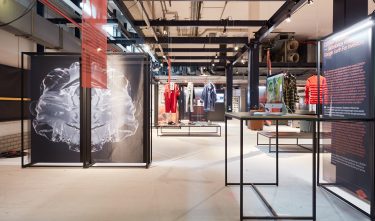Read the international take on Dutch Design Awards by Giovanna Dunmall. It’s not as easy to define Dutch design as people like to think. It’s always been conceptual, speculative and no-nonsense, cutting across social, economic and political boundaries with curiosity, humour and confidence.
 1
1
“A certain amount of daring seems to be a prerequisite,” agrees Evelien Reich, editor-in-chief of Elle Decoration NL and Jury chairperson for the Young Designer section of the Dutch Design Awards. Yet design out of the Netherlands is increasingly collaborative, entrepreneurial and digitally-minded too, unafraid to use technology and often more intent on creating sustainable systems and democratising processes than designing one-off products. Given the past 18 months of restrictions, this urgent can-do approach is more welcome than ever.
A good example of this systems-based approach is BYBORRE Create™, nominated in the Product category. A design tool for customised textile creation it gives makers direct access to the latest knitting machines and a library full of responsible yarns and production facilities. The software aims to reduce over-production and waste (which is rampant in the industry, especially in R&D) and create more resilient and seamless supply chains. Above all, it brings innovation and choice to a dysfunctional sector that has never been fully modernised, where fibre and yarn makers drive the textile industry instead of the creatives and brands actually using the textiles.
Technology-led systems designed to reduce our planetary footprint abound among the rest of this year’s nominees too. In the Data & Interaction category for example, Globalance World is an open digital platform that measures the global impact of investments, while Lely Sphere (a nominee in the Product category) is a friendly-looking red-breasted robot that converts excess nitrogen on dairy farms into fertiliser substitutes. Lely Sphere isn’t only a smart solution to a real problem however, it is a way for farmers to signal that they are playing their part ecologically. “It communicates to passerby that farmers are willing to change and be a part of solving the nitrogen surplus issue,” says journalist and curator Ingeborg van Lieshout, Jury chairperson for the Product category of the awards.
Looking at the nominees in this year’s awards, it seems clear that designers in the Netherlands are grappling with how to navigate a world that is changing vertiginously fast and that appears more unstable than ever. Refreshingly, these designers aren’t prepared to take the post-pandemic societal landscape as a given or as sacrosanct; they are keen to challenge and question it. Projects like Good Neighbours by Amsterdam-based Affect Lab, a nominee in the Design Research category, show how this can be done with flair and wit.
By using research-led immersive performances to explore the growing culture of intimate surveillance in neighbourhoods – community WhatsApp groups, Ring doorbells, Tesla cams and websites like Nextdoor – participants can experience the way technology amplifies both the best and worst aspects of human behaviour. The project cleverly shows how seemingly benign technologies can lead to fear and paranoia, with groups claiming primacy over a space or excluding others they decide don’t fit in. “Good Neighbours is design that helps people understand each other instead of polarising opinions,” says van Lieshout. “Listening to and respecting people with different views is key,” she adds. Too often people “go down a rabbit hole of opinions presented as proof.”
In a similar vein, another of the nominees for the Data & Interaction section, Smart Distancing by Jólan van der Wiel and Nick Verstand, explores social distancing from a more playful angle than we usually see, utilising laser projections that change from a line into a squiggle when somebody gets too close to someone else. Yet again this project is aware of the potential nefariousness of the (tracking) technology used, but is interested in highlighting its more positive functions.
It’s perhaps the three nominees for Young Designer of the Year award who best exemplify the diversity of this year’s offerings. By combining her exciting garments with photography, theatre, choreography and video, fashion designer Bodil Ouedraogo explores existing colonial narratives and the way western audiences often relegate West African couture to the category of traditional costume. At the other end of the spectrum, Bob Hendrikx works with living organisms to create radically sustainable objects and homes. His ‘living’ coffin turns people into plant food, literally. The third nominee in this section, Audrey Large, is also operating on the boundaries of several disciplines. Her work has a future-world vibe, blurring the line between the real and the visual by exploring the potential of digital image manipulation in the creation of objects for our material environment. Large says she “sees no hierarchy between the design of the file and the physical outcome” and the jury were taken by her unconstrained approach. “Audrey’s work has an edge,” says Reich, “she lets the algorithms she works with define what the pieces become. The unreality is the point, and with this she is creating a new design language, one that is unhindered by a preconceived idea of what a piece of furniture should look like.”
It’s this openness to experimentation and cross-pollination that makes Large’s contribution, and that of all the other nominees this year, so ground-breaking. The Dutch design landscape doesn’t sit still. It is constantly striving to understand – and disrupt – the world it sees around it. That can only be a good thing.